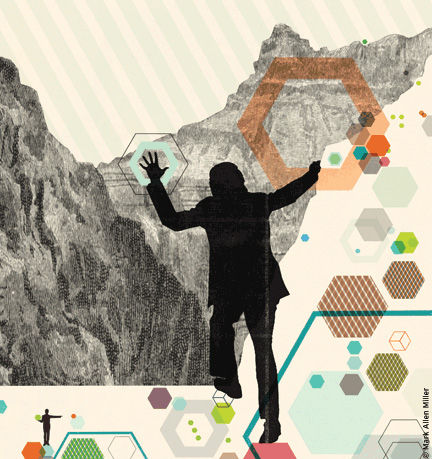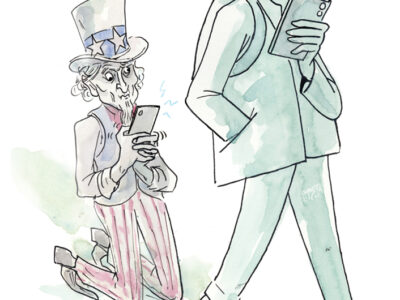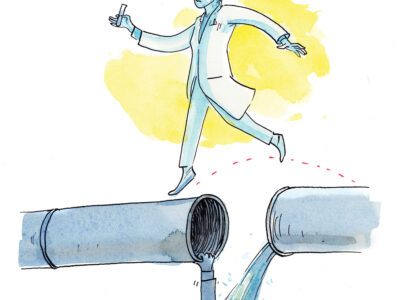
Afghans may be weary of war, but they’re hungry for civil intervention.
By Adam Levin
The plane from Dubai to Kabul was packed, and my fellow travelers dumbfounded me with their diversity. There was, of course, the standard-issue contingent of six-foot-two, 200-pound ex-soldiers reliving their Desert Storm glory days by working for some shadowy defense contractor. But the majority of the passengers were businessmen and women, arriving to take advantage of the wealth of opportunities in Afghanistan’s “war economy.” To my utter amazement there were even two non-Afghan families—parents happily holding the hands of their children.
In a way, my presence among them was no less strange. I was going to Afghanistan under the aegis of the Annenberg School’s Center for Global Communication Studies, which had hired me to design programs to empower local media and rule of law in the war-torn country.
As a former employee for the NATO Parliamentary Assembly and a consultant for political risk management firms—defense contractors, to be blunt—I was not unfamiliar with the risks and constraints of operating in Afghanistan, but the opportunity to direct on Penn’s behalf one of the largest and most ambitious media-development programs ever funded by the US Agency for International Development was one I couldn’t pass up.
Touching down in Afghanistan to thunder-snow—something I’d never imagined to be meteorologically feasible—only added to the eeriness. The traffic patterns of Kabul did nothing to drive that feeling away. Toyota 4Runners, taxis, and sedans from the early 1990s traversed a gauntlet of nonexistent traffic lights and omnipresent roundabouts in abrupt bursts of acceleration and deceleration, swerving across the non-existent centerline to avoid craters in the semi-paved streets. Yet this unorthodox, videogame driving style was oddly comforting; no one wants to spend more time on the road than necessary. And finally we arrived at my guesthouse. It was situated off of a back alley and enclosed by a perimeter wall that made it impossible to know what stood within the enclosure. As I got out of the vehicle, I thought that the driver had mistakenly taken me to a detention center. But the armed Afghan standing outside seemed to be awaiting my arrival and kindly opened a metal chamber door for me to enter. As I walked through the passage, I entered a small, enclosed waiting-room where two smiling Afghans strapped with Kalashnikovs rummaged through my belongings before welcoming me to my new home.
Later that day, I was warmly greeted by an energetic team of employees from Internews, an international media-development organization that would be serving as the main implementer of USAID’s Afghanistan Media Development and Empowerment Project (AMDEP). Internews had assembled a consortium of partner organizations, including Annenberg, to execute the comprehensive and far-reaching objectives of AMDEP. While happily inviting me into their circle of trust, the Internews team was quite curious—indeed skeptical—about how I planned to implement my part of the project, given the results-oriented expectations and the short time frame.
It was a fair question. Back in 2001, after the founding of a democratic regime in Afghanistan, local journalists found new opportunities to raise their voices, and an unprecedented number of media outlets were established. But despite these opportunities, roadblocks to freedom of expression and access to information—combined with the unlawful detention, kidnapping, and even murder of media personnel—remained. Thus, my objective was to foster and empower a network of Afghans who could advocate for freedom of expression through legal reforms that would strengthen the rule of law and support the growth of an independent, robust, and energetic media sector.
Yet whether the effort could gain traction was very much an open question. The deterioration of security in Afghanistan—and particularly in Kabul—in the early part of 2011 had already become painfully evident. In fact it had delayed my arrival. About a month before, a suicide bomb killed a family at the Finest Supermarket in Kabul, and due to a subsequent visa delay I was forced to cancel a meeting at Kabul’s Safi Landmark Hotel. Shortly thereafter, the man with whom I had to cancel contacted me through Skype to thank me: on the day we were scheduled to meet, the Safi Landmark’s entrance had exploded in broad daylight.
Returning to Afghanistan in September 2011 for my fourth time in less than a year, the uncertain state of affairs persisted. On September 13 the Taliban launched a string of attacks spanning a 12-hour period that targeted the US Embassy compound, NATO headquarters, and the diplomatic area, as well as a high school in Kabul. Although international and Afghan forces responded and overpowered their assault, the Taliban had amply demonstrated their capacity to execute simultaneous, coordinated attacks in the heart of Afghanistan, even while engaging NATO in an online Twitter debate.
After a decade since the start of the US war in Afghanistan, most Americans interpret these events as commonplace occurrences as they watch the nightly news from the sanctuary of their living rooms. My perspective was quite different—partly because I had concluded a meeting with USAID officials at the embassy compound only 10 minutes before the attack began, and partly because what happened immediately afterward demonstrated to me the extent of the impact a media-empowerment program can have for the Afghans I found myself working with.
After leaving the embassy compound, I proceeded to an outdoor meeting at the Afghanistan Independent Bar Association, where 45 lawyers from across Afghanistan had assembled in Kabul to set up the Afghanistan Media Defense Lawyers Committee. This USAID initiative aimed to protect journalist’s rights, defend freedom of information and expression, and advocate for media law and policy. Despite the surrounding chaos of small-arms fire, rocket-propelled grenades, and helicopters that echoed throughout the city, I sat outside in utter amazement and admiration as these lawyers passionately continued the meeting from morning to sunset.
On the way back to the serenity of my well-guarded guesthouse later that evening, I reflected upon both the staggering constraints and opportunities of working in Kabul, and the unordinary yet inspiring occurrences of the day. As I approached my guesthouse, I passed an Afghan wedding where 800 people celebrated against a backdrop of blaring music, as though the day’s events had never happened. I realized that amid all the violence and anarchy, life continues.
After attempting to explain to friends and family what I do, I am frequently asked something like: Given the daunting domestic pressure and social ills that we are struggling with in America, what is the purpose of consuming taxpayers’ dollars to support military or development programs in Afghanistan? American opinion polls about US involvement in Afghanistan and political policies demonstrate an inward-looking sentiment. This semi-isolationist movement scarily suggests that we have quickly forgotten the lessons of history. If there was anything to be learned from the United States’ failure to continue to support Afghanistan after the withdrawal of Soviet forces in the late 1980s, then the current scaledown of military operations should, if anything, warrant an increase in support for the development of programs and institutions that help to build the infrastructure of civil society in Afghanistan.
My involvement with AMDEP this past year illustrates the impact and efficacy of these programs. Through our coordinated efforts, Afghan lawyers participated in a training program centered on core concepts of media law, media-management law, and information and communication technologies law. Working with lawyers and Afghan government ministries, I also approached professors and students from Afghan universities to build media and legal capacity through moot court, a practical legal simulation in which students compete against other schools by developing legal briefs and delivering oral pleadings. Though unclear about what moot court actually entailed at the time, students from Alberony, Balkh, Herat, Kabul, and Nangarhar universities excitedly agreed to participate. Through our work on the university level, we launched the first bilingual Media Law Moot Court Competition in Afghanistan, and students have already expressed an excitement to participate en masse in the competition next year. We also established the Afghanistan Media Defense Lawyers Committee, which serves as a forum for lawyers with an interest in media law and policy to share best practices, improve media defense litigation skills, and promote the professional standards and development of media law advocates.
One is faced with numerous challenges when engaging in efforts to build rule of law and influence a country’s legal and media systems. Though it will take time, I believe our programs will shape the country’s actual media and judiciary for the better. Building a moot court program in Afghanistan strengthens legal writing skills, inculcates the virtue of oral persuasion before a panel of judges in the presence of an opposing team, and provides Afghan students with a practical legal experience outside the classroom. Afghan law students are learning about national and international legal issues pertaining to privacy, freedom of expression and opinion, defamation, regulation of the media, and the application of laws and conventions such as the Afghanistan Mass Media Law, the Universal Declaration of Human Rights, and the International Covenant on Civil and Political Rights. On a parallel track, we are also assisting with the development of curriculum at law faculties across the country. Expanding students’ knowledge of national and international laws pertaining to media law and policy is critical to the development of a free and independent media sector in Afghanistan.
The passion and enthusiasm of Afghans who have since become involved with this initiative has been inspiring to say the least. Witnessing the impact of our program and talking with Afghan lawyers and students who want to participate in our activities is a source of personal motivation that has led me to continually return to Afghanistan. From these seeds, hopefully, a safer and more stable Afghanistan will eventually blossom.
Adam Levin C’07 returned to Afghanistan this winter for his fifth trip. He can be reached at adamhlevin@gmail.com.




